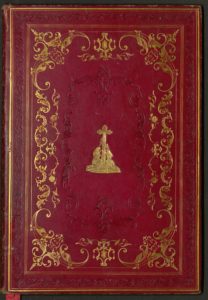What do Indiana Jones and the Content Services Mosaic Intern have in common? We both spend our days searching for historical treasure: in my case that involves paging through old texts—often plain or even dirty in appearance—researching their autographs and marginalia, and mining valuable snippets of the lives of people important to both our local and national history. Occasionally, I do have the opportunity to handle a book whose cover reflects its treasure inside, like the Canon Missae ad Usum Episcorum, ac Praelatorum Solemniter, vel Private Celebrantium (1755), donated by Ralph H. Wark and Patrick Hayes.
 Full-bound in red morocco with gilt tooling, blind stamping, and gilt design.
Full-bound in red morocco with gilt tooling, blind stamping, and gilt design.
The Canon Missae, or Canon of the Mass, is part of the Roman Missal, the liturgical text for the celebration of the Mass in the Roman Catholic Church. This edition, as was common until the the Second Vatican Council (1962-1965), is written wholly in Ecclesiastical Latin.
In addition to the text are engraved vignettes and full-page illustrations, rich with sacred and allegorical scenes.
![Detail of vignette signed “M. Beylbrouck sculp[it].”](https://libraries.wm.edu/sites/default/files/images/scrc-archive/2017/08/BX2015.6.A2_1755_Vignette-300x207.jpg) Detail of vignette signed “M. Beylbrouck sculp[it].”
Detail of vignette signed “M. Beylbrouck sculp[it].”For example, the vignette to the left depicts the authority of the Catholic Church as given by God. Underneath the wings of the Holy Spirit, in the form of a dove, rest two female figures who appear to be a double allegorical representation of the Catholic Church or papacy. Veiled, the woman on the left shows the Church as the bride of Christ. She holds a cross as well as a chalice and host, signifying the Sacraments of the Catholic Church. The woman on the right rests her hand on an anchor, a symbol of the Church’s authority. At the center of the vignette, directly beneath the Holy Spirit, lies the papal insignia.
Most of the full-page engravings were signed by a woman, Suor [Sister] Isabella Piccini. Elisabetta Piccini (1644-1734), who later took the name Isabella when she entered the Convent of Santa Croce, learned her artistic skill from her father, Giacomo, a Venetian engraver. She contributed engravings to many liturgical books, biographies of saints, and prayer manuals published in Venice. (Although one may find it strange that Suor Isabella’s work predates this book, it was not uncommon for plates of engravings to be reused in printings.)
![Bottom left-hand corner: Suor Isabella P[iccini] f[ecit].](https://libraries.wm.edu/sites/default/files/images/scrc-archive/2017/08/BX2015.6.A2_1755_Engraving-216x300.jpg) Bottom left-hand corner: Suor Isabella P[iccini] f[ecit].
Bottom left-hand corner: Suor Isabella P[iccini] f[ecit].In the image seen here on the right, Suor Isabella masterfully depicts the Seventh Station of the Cross: Jesus falls the second time. Take time to look at each individual. With the halo drawing the viewer’s eyes to Jesus’s face at the center of the engraving, one sees sweat and tears and exhaustion. Follow Christ’s eyesight to the woman in the bottom left-hand corner staring back worriedly. Look at the cloth she is holding, which bears the face of Jesus. The imagery identifies the woman as Veronica. Let your eyes roam over the expressions of the soldiers. Suor Isabella leaves no doubt as to what each person is feeling in that moment.
I could go on—this article barely scratches the surface of the magnificence of this Canon Missae—but I think this is something you should see in person. Bonus: Swem Library holds two other editions! Come discover these breathtaking treasures yourself at Special Collections.
Written by Olivia Jameson, Mosaic Intern